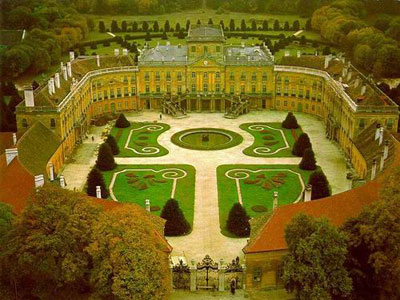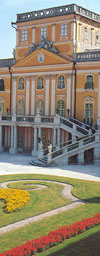Fertőd - formerly Eszterháza
 |
The Eszterházy Castle is the third biggest historical building complex in Hungary. The Baroque castle, also known as 'the Hungarian Versailles', was built by Miklós Esterházy the 'Glorious' between 1763 and 1766. He and his high-spirited wife, Countess Margit Cziráky, rebuilt the 20-roomed hunting lodge of József Esterházy, transforming it into the family's favourite home. This was the golden age of the building, between 1768 and 1790. After the owner’s death, it lost its prominent role, and during World War II it fell into ruin.
 |
The facade of the castle has almost every ornamental element of the Baroque style. The symmetry of the building, along with the richly ornamented arched stairs leading to the Music Room and the Ceremony Hall, are a fascinating sight. The main characteristic of Miklós's court was its high level of culture. The marvellous interiors and the plentiful decoration of the 126 rooms will amaze every visitor. As a generous Maecenas, the owner transformed his court into a true cultural centre. Joseph Haydn, the outstanding musician of the period, served the family for 30 years. The opera performances were often held in the presence of the royal family. Haydn composed a large number of his masterpieces here; the momentos of his life's work fill three rooms. The famous Gallery of the castle, with its 348 paintings, provides a basis for the National Gallery. The arch-shaped castle complex surrounds a ceremonial courtyard built in Baroque–Rococo style. At the end there is a magnificent three-part wrought-iron gate. The permanent exhibition of Fertőd's regional history is in the former residence of Haydn.